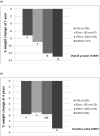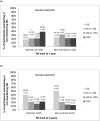Objectively Assessed Physical Activity and Weight Loss Maintenance among Individuals Enrolled in a Lifestyle Intervention
- PMID: 28940967
- PMCID: PMC5695666
- DOI: 10.1002/oby.21971
Objectively Assessed Physical Activity and Weight Loss Maintenance among Individuals Enrolled in a Lifestyle Intervention
Abstract
Objective: To examine the relationship between objectively assessed moderate-to-vigorous intensity physical activity (MVPA) and 4-year weight loss (WL) and WL maintenance among individuals with diabetes enrolled in the Look AHEAD trial.
Methods: MVPA was measured in a subgroup of lifestyle intervention participants with accelerometry data at baseline and at 1 and 4 years (n = 553; age: 59.7 ± 6.8 y; BMI: 35.5 ± 5.9 kg/m2 ). Minutes per week of bout-related MVPA were calculated (≥ 3 metabolic equivalents, ≥ 10-min bouts), and adherence to the national physical activity (PA) recommendation for WL maintenance (≥ 250 min/wk) was assessed.
Results: Independent of 1-year WL, 4-year MVPA (β = -0.003, SE = 0.002, P = 0.006), but not 1-year MVPA (β = 0.0001, SE = 0.001, P = 0.50), was significantly associated with 4-year WL. Compared with "nonmaintainers" (≥ 10% WL at year 1, but < 10% at year 4; n = 132), WL maintainers (≥ 10% WL at years 1 and 4; n = 103) had higher MVPA at year 1 (253.4 ± 251.8 vs. 163.9 ± 158.2 min/wk, P = 0.002) and year 4 (155.3 ± 180.6 vs. 111.4 ± 154.5 min/wk, P = 0.046). Although 38.8% and 22.3% of WL maintainers engaged in ≥ 250 min/wk at years 1 and 4, respectively, many engaged in < 150 min/wk (year 1: 41%, year 4: 61%).
Conclusions: Higher weekly MVPA is associated with greater long-term WL and weight maintenance; however, many individuals are able to maintain ≥ 10% WL while engaging in little MVPA.
Trial registration: ClinicalTrials.gov NCT00017953.
© 2017 The Obesity Society.
Conflict of interest statement
Figures


Similar articles
-
Four-Year Physical Activity Levels among Intervention Participants with Type 2 Diabetes.Med Sci Sports Exerc. 2016 Dec;48(12):2437-2445. doi: 10.1249/MSS.0000000000001054. Med Sci Sports Exerc. 2016. PMID: 27471785 Free PMC article. Clinical Trial.
-
Pattern of Daily Steps is Associated with Weight Loss: Secondary Analysis from the Step-Up Randomized Trial.Obesity (Silver Spring). 2018 Jun;26(6):977-984. doi: 10.1002/oby.22171. Epub 2018 Apr 6. Obesity (Silver Spring). 2018. PMID: 29633583 Free PMC article. Clinical Trial.
-
Objectively-assessed physical activity and weight change in young adults: a randomized controlled trial.Int J Behav Nutr Phys Act. 2017 Dec 4;14(1):165. doi: 10.1186/s12966-017-0620-x. Int J Behav Nutr Phys Act. 2017. PMID: 29202850 Free PMC article. Clinical Trial.
-
Temporal patterns of physical activity in successful weight loss maintainers.Int J Obes (Lond). 2021 Sep;45(9):2074-2082. doi: 10.1038/s41366-021-00877-4. Epub 2021 Jun 14. Int J Obes (Lond). 2021. PMID: 34127805 Free PMC article.
-
Effectiveness of activity trackers with and without incentives to increase physical activity (TRIPPA): a randomised controlled trial.Lancet Diabetes Endocrinol. 2016 Dec;4(12):983-995. doi: 10.1016/S2213-8587(16)30284-4. Epub 2016 Oct 4. Lancet Diabetes Endocrinol. 2016. PMID: 27717766 Clinical Trial.
Cited by
-
Behavioral Predictors of Weight Regain in Postmenopausal Women: Exploratory Results From the Breast Cancer and Exercise Trial in Alberta.Obesity (Silver Spring). 2019 Sep;27(9):1451-1463. doi: 10.1002/oby.22569. Epub 2019 Jul 18. Obesity (Silver Spring). 2019. PMID: 31318492 Free PMC article. Clinical Trial.
-
Effects of meeting steps-based and minutes-based physical activity goals on weight loss in online behavioral weight control: seemingly unrelated regression analysis.Health Psychol Behav Med. 2022 Oct 3;10(1):956-972. doi: 10.1080/21642850.2022.2129654. eCollection 2022. Health Psychol Behav Med. 2022. PMID: 36210867 Free PMC article.
-
Perceived importance of moderate-to-vigorous physical activity as a weight control strategy in behavioral weight loss.Obes Sci Pract. 2023 Jul 8;9(6):631-640. doi: 10.1002/osp4.695. eCollection 2023 Dec. Obes Sci Pract. 2023. PMID: 38090685 Free PMC article.
-
Episodic future thinking, delay discounting, and exercise during weight loss maintenance: The PACE trial.Health Psychol. 2020 Sep;39(9):796-805. doi: 10.1037/hea0000860. Health Psychol. 2020. PMID: 32833481 Free PMC article.
-
Perceived barriers to physical activity during and after a behavioural weight loss programme.Obes Sci Pract. 2019 Dec 19;6(1):10-18. doi: 10.1002/osp4.373. eCollection 2020 Feb. Obes Sci Pract. 2019. PMID: 32128238 Free PMC article.
References
-
- Donnelly JE, Blair SN, Jakicic JM, Manore MM, Rankin JW, Smith BK. American College of Sports Medicine Position Stand. Appropriate physical activity intervention strategies for weight loss and prevention of weight regain for adults. Med Sci Sports Exerc. 2009;41(2):459–71. - PubMed
-
- Wadden TA, Vogt RA, Foster GD, Anderson DA. Exercise and the maintenance of weight loss: 1-year follow-up of a controlled clinical trial. J Consult Clin Psychol. 1998;66(2):429–33. - PubMed
-
- Leser MS, Yanovski SZ, Yanovski JA. A low-fat intake and greater activity level are associated with lower weight regain 3 years after completing a very-low-calorie diet. J Am Diet Assoc. 2002;102(9):1252–6. - PubMed
MeSH terms
Associated data
Grants and funding
- U01 DK057151/DK/NIDDK NIH HHS/United States
- U01 DK057154/DK/NIDDK NIH HHS/United States
- U01 DK056992/DK/NIDDK NIH HHS/United States
- U01 DK057171/DK/NIDDK NIH HHS/United States
- R01 AG018915/AG/NIA NIH HHS/United States
- U01 DK057182/DK/NIDDK NIH HHS/United States
- U01 DK057136/DK/NIDDK NIH HHS/United States
- U01 DK057002/DK/NIDDK NIH HHS/United States
- U01 DK057177/DK/NIDDK NIH HHS/United States
- M01 RR001066/RR/NCRR NIH HHS/United States
- U01 DK057078/DK/NIDDK NIH HHS/United States
- K01 DK100498/DK/NIDDK NIH HHS/United States
- U01 DK057008/DK/NIDDK NIH HHS/United States
- U01 DK057149/DK/NIDDK NIH HHS/United States
- P30 AG021332/AG/NIA NIH HHS/United States
- P30 DK048520/DK/NIDDK NIH HHS/United States
- U01 DK057135/DK/NIDDK NIH HHS/United States
- UL1 RR024153/RR/NCRR NIH HHS/United States
- P30 DK046204/DK/NIDDK NIH HHS/United States
- M01 RR002719/RR/NCRR NIH HHS/United States
- M01 RR000056/RR/NCRR NIH HHS/United States
- U01 DK057219/DK/NIDDK NIH HHS/United States
- U01 DK057131/DK/NIDDK NIH HHS/United States
- M01 RR000051/RR/NCRR NIH HHS/United States
- P30 DK026687/DK/NIDDK NIH HHS/United States
- U01 DK056990/DK/NIDDK NIH HHS/United States
- UL1 RR025758/RR/NCRR NIH HHS/United States
- U01 DK057178/DK/NIDDK NIH HHS/United States
- M01 RR001346/RR/NCRR NIH HHS/United States
- P30 DK017047/DK/NIDDK NIH HHS/United States
LinkOut - more resources
Full Text Sources
Other Literature Sources
Medical

